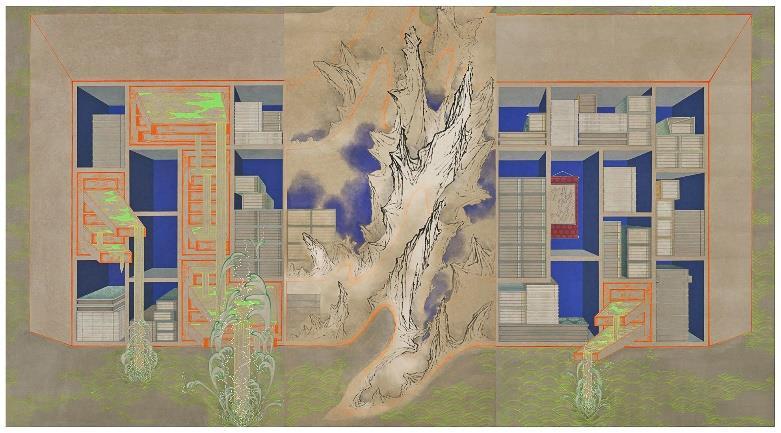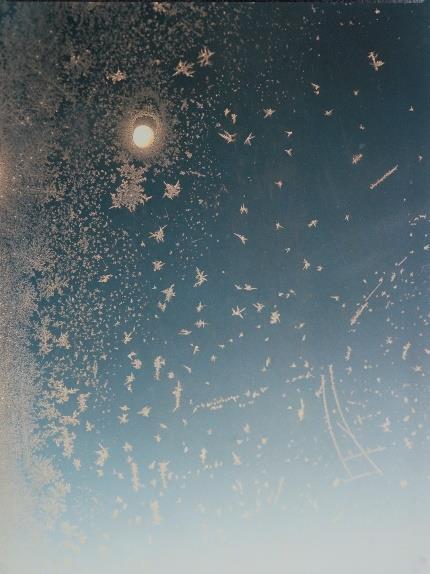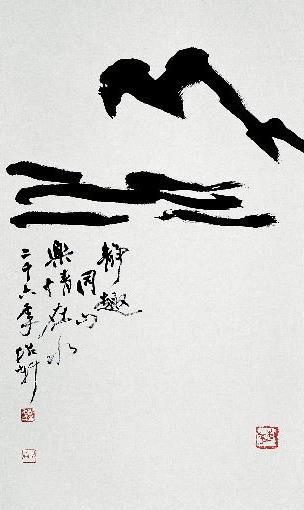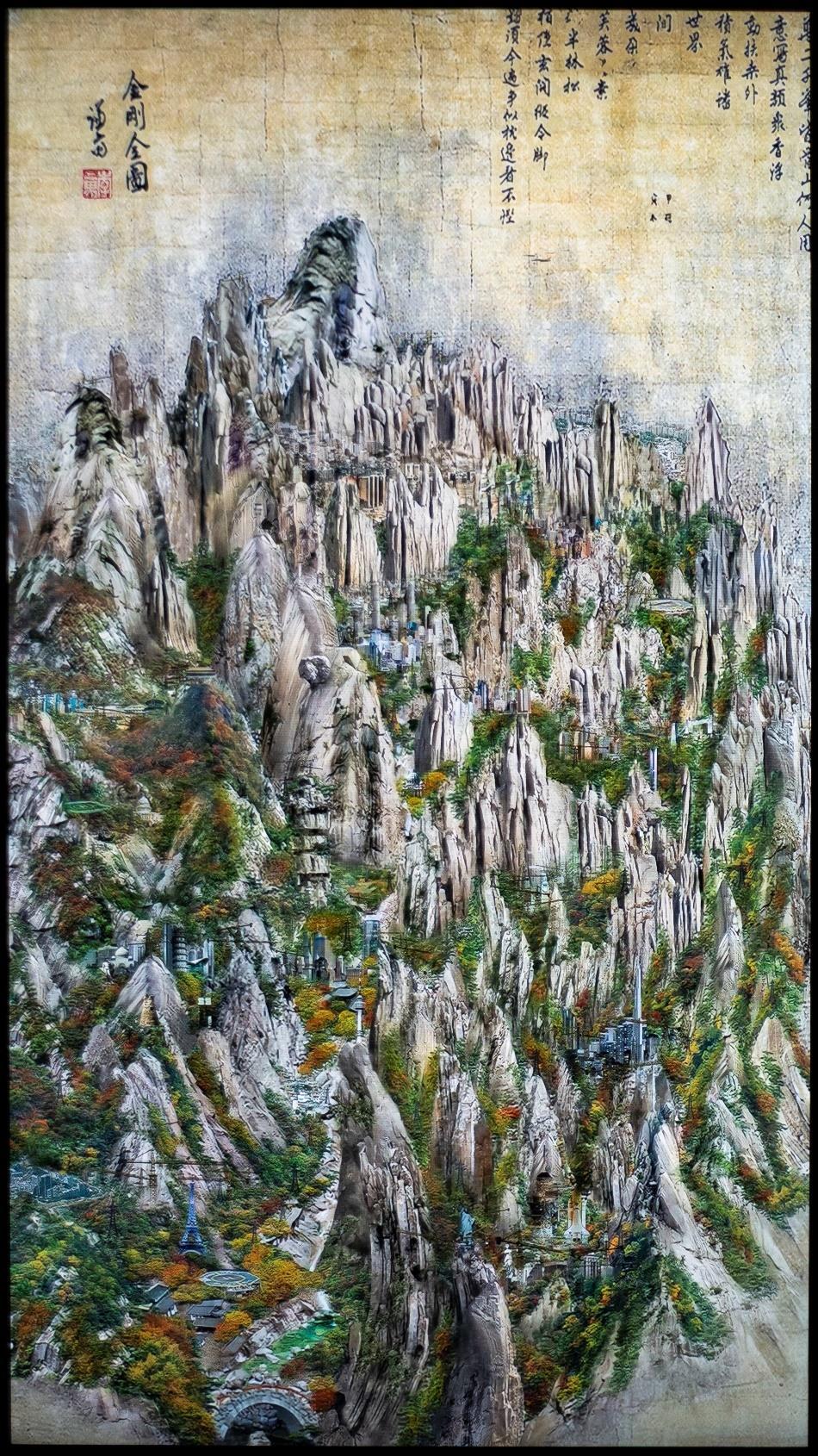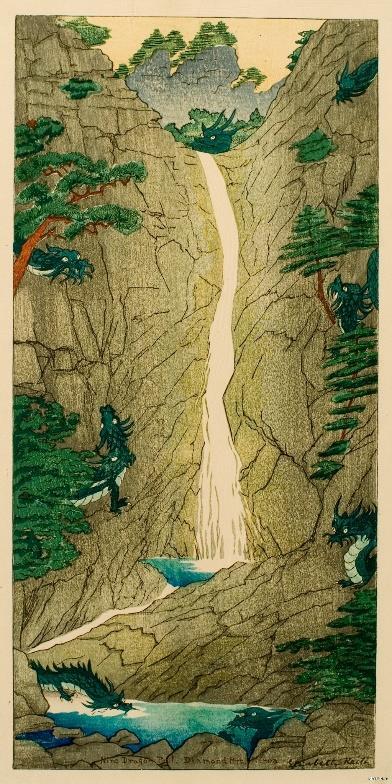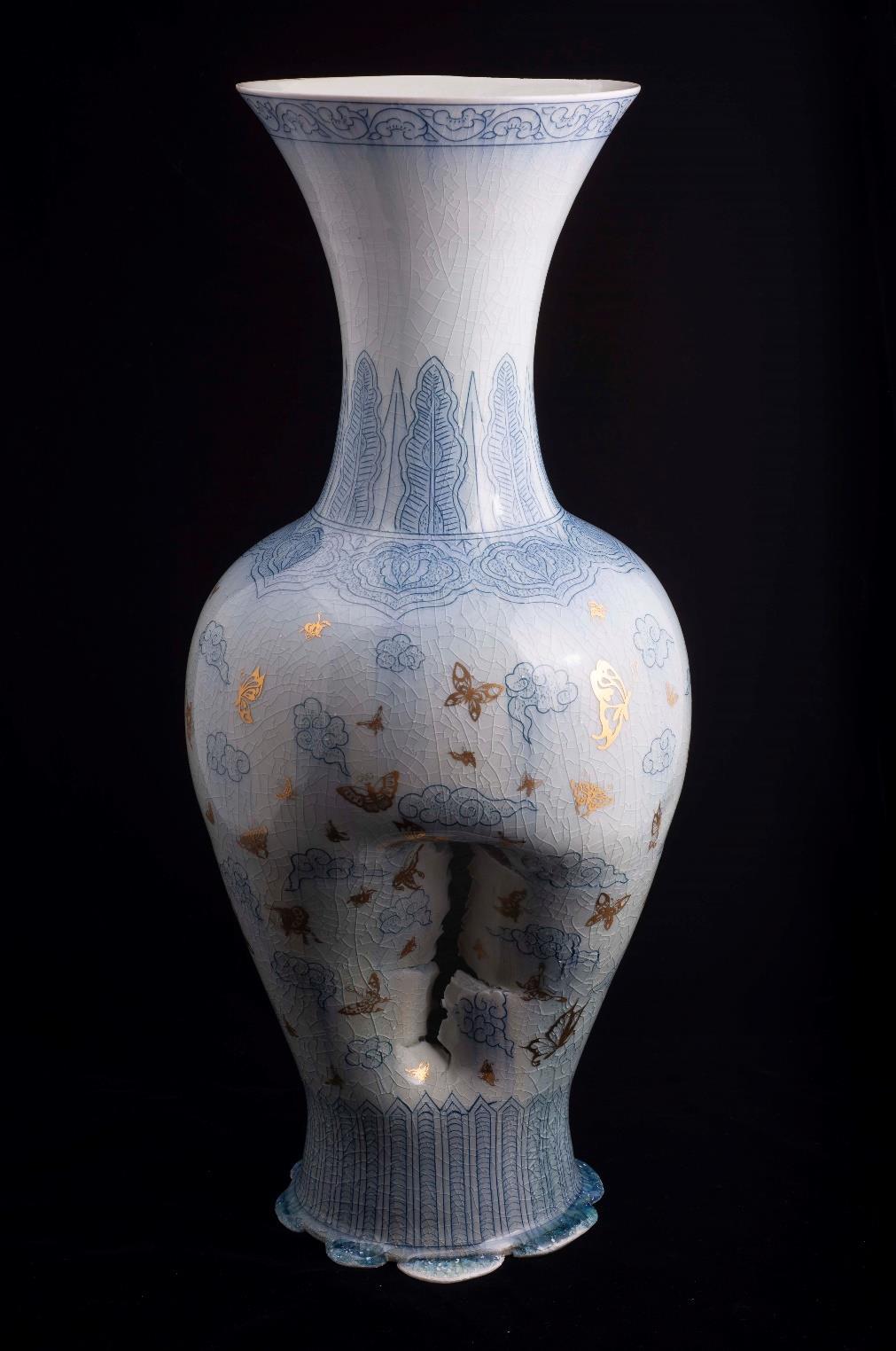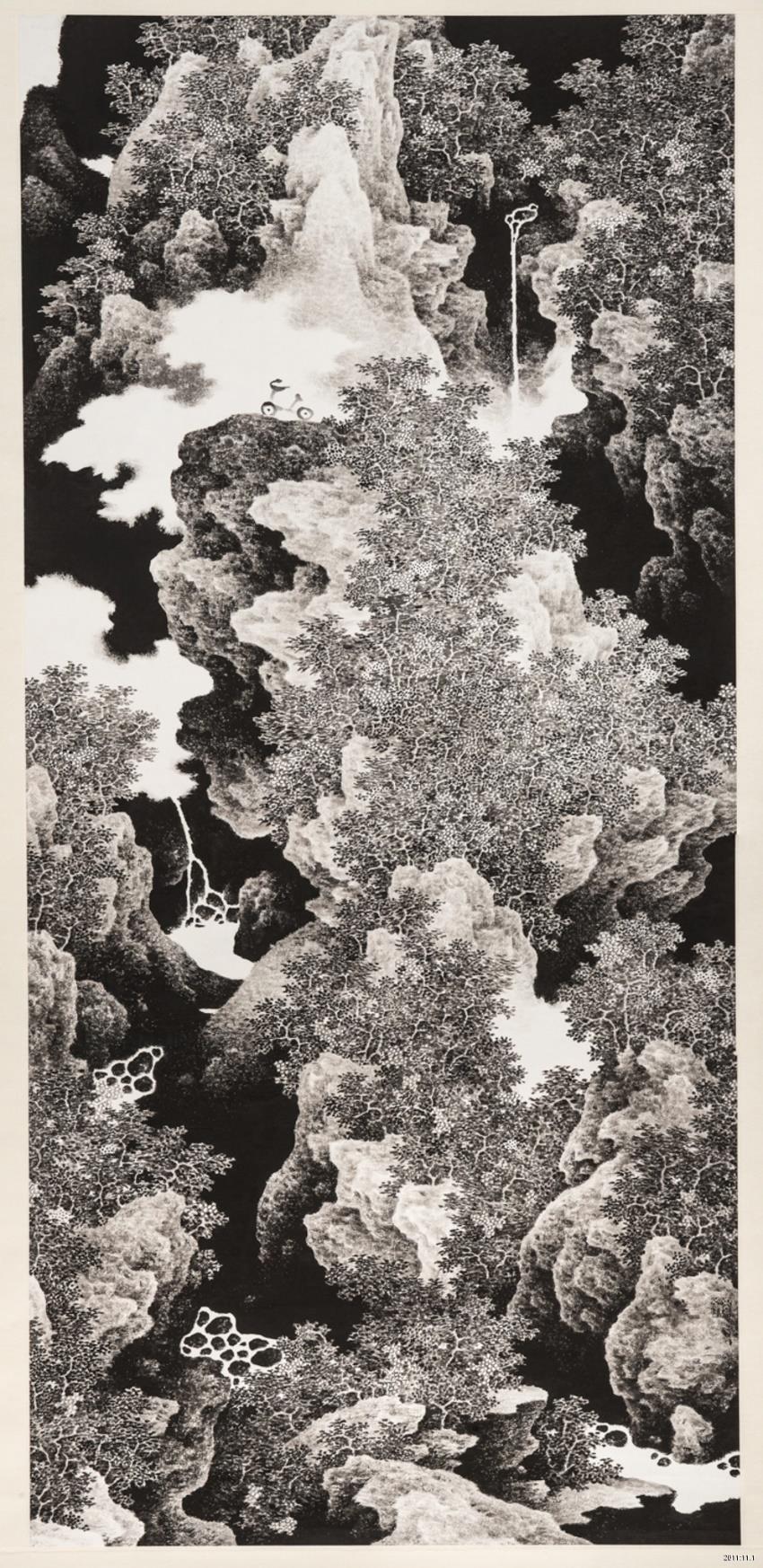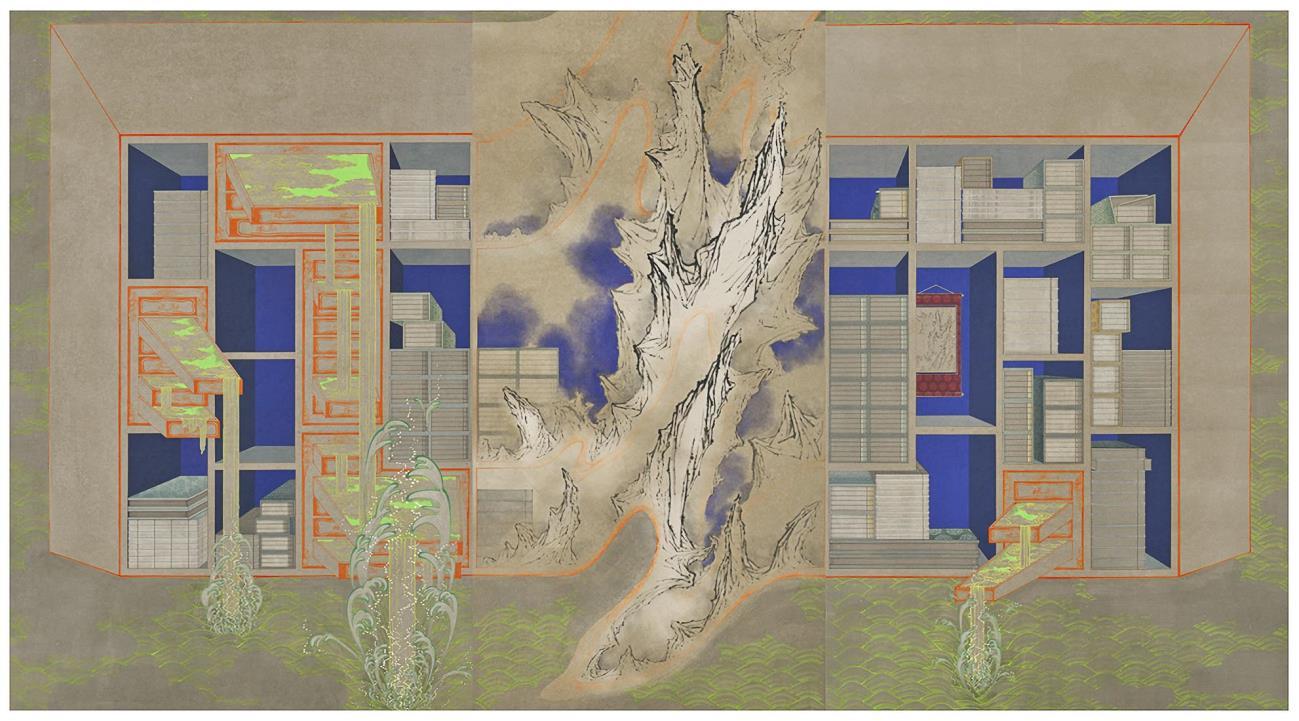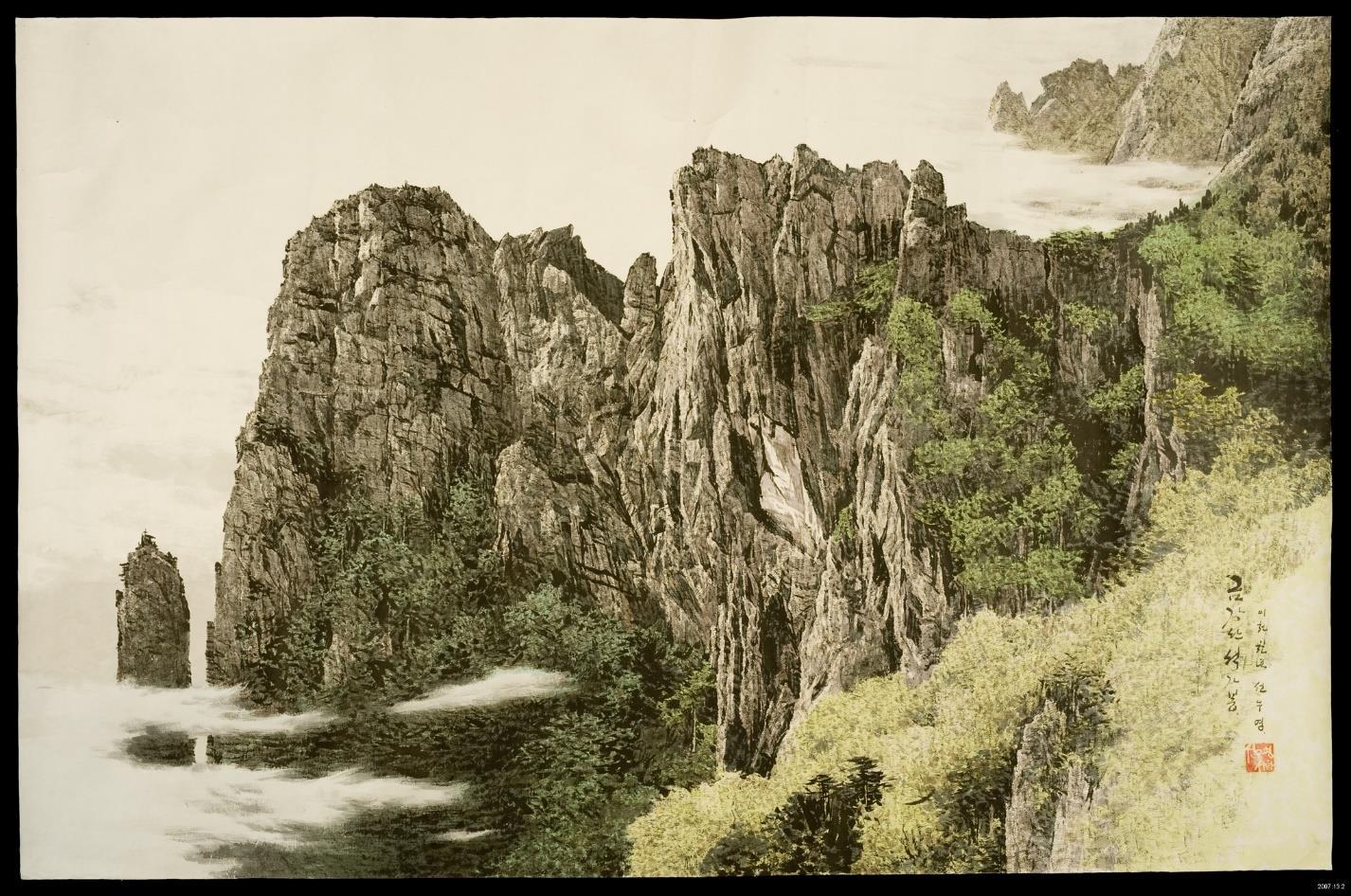Wan Koo & Young Ja Huh Wing Gallery
JUNG Hyun-Bok, 鄭鉉輻, 정현복
(aka Yoodang, 惟堂, 유당; 1909-1973)
Korean; Republic of Korea, 1970
“Appearance of a Pine Tree, Conduct of a Crane” (松姿鶴操, 송자학조, Song Ja Hak Jo)
Framed calligraphy in Chinese characters; ink on paper
Gift of JUNG Do -jun, 2010:28.1
Jung Hyun-Bok’s Appearance of a Pine Tree, Conduct of a Crane refects a long-standing philosophical idea and Korean auspicious belief with the artist’s original, unique style of calligraphy. The pine tree and crane are two elements of the Ten Symbols of Longevity, which together signify a long, healthy life but also respectively symbolize signifcant meanings through Korean history. With their ever-green leaves, pines signify integrity and fdelity, whereas cranes symbolize long life, erudite scholars, and vehicles for Daoist immortals. In this composition, calligrapher Jung Hyun-Bok uses his brush to elegantly describe each character like a pictorial form, expressing his generous and liberal personality. An artist of national acclaim since 1936, Jung was known for simultaneously inheriting traditional calligraphic methods while embodying his own unafected style of semi- cursive script.
JUNG Do -jun, 鄭道準, 정도준 (aka Sohyun, 紹軒, 소헌; born 1948)
Korean; Republic of Korea, 2006
Mountain and Water (山河, 산하, Sanha)
Framed calligraphy in Chinese characters; ink on paper
Murray Warner Acquisition Fund Purchase, 2007:2.1
Jung Do -jun is an internationally acclaimed contemporary Korean calligrapher who is known for inventing his original, individual practice, which creatively intertwines boundaries between writing and art. Infuenced by his father, master calligrapher Jung H yun-bok (1909-1973), and his subsequent teacher, Kim Chong-hyun (19212006), Jung Do -jun’s work is rooted in the calligraphic tradition, but simultaneously employs innovative artistic devices. It is especially recognized for his usage of seal script (the oldest form of Chinese characters) and hangeul (Korea’s phonetic syllabary), often described as unconventional forms that resemble pictorial elements.
In this composition, the written characters for “landscape” ( 山河; Chinese, shanhe; Korean, sanha) echo primitive pictorial forms of mountain and water, the original elements they describe.
LEE Lee-Nam, 李二男, 이이남 (born 1969)
Korean; Republic of Korea, 2009
New Geumgangjeondo (New Complete View of Mount Geumgang)
7 minute, 10 second single channel video installation on 65 inch LED TV, edition 1/6
Museum purchase with funds from the Farwest Steel Korean Art Endowment and Ballinger Funds in honor of Jill Hartz, 2019:36.1
A celebrated video artist in contemporary Korea, Lee Lee -Nam breathes life into classical masterpieces of Asia and Europe, animating and transforming them into new provocative images which often serve as signifers of dissonant but harmonious relations between cultures. For the New Geumgangjeondo, Lee depicts a succession of seasonal views of the Diamond Mountains in North Korea. He borrowed the original landscape from Geumgangjeondo by Jeong Seon (1676-1759), the father of Korean “True-View” landscape painting (jingyeong sansuhwa). Lee Lee-Nam creates a completely unexpected scene at the end of the video, in which the mountain becomes a hybrid zone of historical and global contemporary monuments surrounded by military helicopters. The pristine beauty of the Diamond Mountains is deconstructed as the brilliant splendor of urban-scapes, questioning socio -political notions of the terrain in the contemporary world.
O Myeong-seon, 吳明善, 오명선
Korean; Joseon dynasty or Colonial period, circa 1880s-1940s
Landscape (山水圖, 산수도, Sansudo)
Hanging scroll; ink with white pigment on silk
Gift of Colonel Daniel Z. Boyd in memory of Jacqueline Zurcher Boyd, 1998:11.1
This artwork is attributed to the unidentifed artist O Myeong-seon. In the lower-left corner of the piece, O Myeong-seon's name is inscribed in Hanja characters, while below it, the artist’s red seals, reading “O Myeong-seon-in” (吳明善印) and “Munsan” (問山) are visible. This artwork depicts tranquil evening scenery by the riverside with a rising full moon. The high rocky mountains in the background contrast harmoniously with the towering trees in the foreground. The composition, reminiscent of traditional landscape paintings, emphasizes the foreground clifs and trees while employing mist and other vacant spaces to depict the background and middle ground. However, the realistic portrayal of the trees refects a transition from traditional to modern landscape painting techniques. The depiction of the clif's refection in the water demonstrates realistic brushwork and depiction methods, more akin to modern expressions. This artwork showcases serene and poetic riverside scenery while demonstrating changes in brushwork techniques over time.

Sangyon JOO (JOO Sangyon, 주상연; Korean, born 1970)
Untitled, from Wonder on Parnassus series, 2007
Inkjet print on Hahnemuhle paper
Gift of the PhotoAlliance Board of Directors, 2021:15.24
Transnational artist Sangyon Joo conceives of photography as a tool to present her mindscape, which includes not just her internal emotions but also her thinking, logic, memories, and senses. Sparked by her essential curiosity and wonderment, she sensually engages with nature by capturing landscapes under bright, exquisite, natural light. The Parnassus is Joo’s metaphor of the West Coast, specifcally San Francisco, where since 2007 she encountered and began to admire the predominant history and education of photography in the region; originally the Parnassus is the sanctuary of the arts in Greek and Roman mythology. For this photograph, Joo pressed the shutter at a moment when she was obsessed by the beauty of the frosted sunlit view when she opened her air plane window shade during a fight from Seoul to Europe. The surrealistic but realistic view embodies her emotional, spiritual, and philosophical journey.
From left to right:
Elizabeth Keith (Scottish, 1887-1956)
Wonsan, Korea, circa 1919-1924
Woodblock print; ink and color on paper
Murray Warner Collection, MWB51:K56
Elizabeth Keith (Scottish, 1887-1956)
The Diamond Mountains, A Fantasy, Korea, 1921
Woodblock print; ink and color on paper
Murray Warner Collection, MWB51:K11
Elizabeth Keith (Scottish, 1887-1956)
Nine Dragon Pool, Diamond Mountains, Korea, 1922
Woodblock print; ink and color on paper
Murray Warner Collection, MWB51:K36
Elizabeth Keith was born in Scotland and traveled throughout Asia, including China, Korea, and Japan, in the early twentieth century, capturing her impressions through drawings, paintings, and woodblock prints. Particularly captivated by Korean culture, she visited Korea four times (in 1919, 1921, 1934, and 1936), portraying the country through her perspective.
Enthralled by the majestic sight of the Diamond Mountains—Mount Geumgang Keith immersed in its splendor. It is speculated that she spent several days exploring the mountain, absorbing the various legends and myths that surrounded it. In her artwork, Buddhist deities grace the rocks, while tigers stealthily blend into the landscape. The Nine-Dragon Pool, where nine dragons are said to guard the Diamond Mountains, stands as a testament to its mythical allure. These elements, drawn from the stories she encountered during her journey, seamlessly intertwine with her artistic expression.
Wonsan, located in the southeastern region of North Korea, is one of the cities beloved by Elizabeth Keith. In her autobiography, she records her fondness for the places she depicted, and the ages - old gnarled pines that appear in her paintings are a recurring motif in her Wonsan scenes. Beyond the misty night, silhouetted islands and boats can be discerned. Drawing the night sky through the twisted pines is a composition frequently used by Japanese artists such as Kawase Hasui (川瀬 巴水, 1883-1957) and other woodblock print designers.
PARK Soeun, 박소은 (born 1976)
Korean; Republic of Korea, 2017
To Be There
Fan painting; ink, color and gold pigment on paper mounted with wooden handle and silk cord
Gift of PARK Soeun, 2018:18.2
Park Soeun explores the human desire to pursue bright, peaceful happiness through her art, which she uses as a communication tool to harmonize with the world. She perceives nature as an ideal, essential space in which one dreams of being, a space that resonates with nostalgic emotions for the transcendent world. In To Be There, Park portrayed mountains and water as a utopian space where one is liberated from anxiety and complicated worldly circumstances, reaching the status of Dao (the natural way of the universe in Daoism) through meditation. While she created this fan painting based on her personal imagined aspiration “to be there in the ideal nature,” the paragliding symbolizes the leisurely freedom and happiness one feels in space. Park used red powder paint and gold pigments to depict the warmth and intensity of the landscape surrounding the contemporary element of fuorescent colors.
Steven Young LEE (Korean American, born 1975)
Vase with Clouds and Butterfies, 2016
Porcelain, cobalt inlay, gold luster, glaze
Farwest Steel Korean Art Endowment Fund Purchase, 2017:45.1
Steven Young Lee re-interprets the idea of perfection and crosscultural references in ceramic art by intentionally deconstructing vessels produced based on the visual elements (forms, colors, and decorations) of traditional East Asian porcelains. He believes that beauty can be found when unexpected possibilities are open, revealing the characteristics and qualities of materials in the process of ceramic making. For this Vase with Clouds and Butterfies, Lee crafted a perfectly shaped blue-and-white porcelain, cracked a portion of its lower part, and fred it in a kiln, expecting to witness a mysterious outcome. The decorative elements of clouds and butterfies represent his profound interest in how motifs can be adapted and interpreted in various Asian and Western cultural contexts, through which he creates a harmony between discordant and/or ironic relationships.
Jin Joo Gallery
Bamboo Through the Four Seasons (墨竹圖, 묵죽도, Mukjukdo)
Korean; Joseon dynasty, 19th- early 20th century
Pair of four-panel folding screens; ink on paper
Loan from Robert and Sandra Mattielli, L2012:3.4
The painting, depicting Bamboo through the Four Seasons , symbolizes the cycles of change in nature. While bamboo represents courage and resilience in Confucianism, it further signifes stability and patience amid seasonal transitions. Bamboo was the most esteemed subject in the examinations for artists recruited by the Bureau of Painting (Dohwaseo) from the Joseon dynasty (1392-1910).
During the mid-Joseon, as Neo -Confucianism became entrenched in society, bamboo paintings, which symbolized the ideals of scholars, gained great popularity among the literati and elites. This composition, which is comprised of eight panels depicting (from right to left) the four seasons, delicately captures the appearance of bamboo at various times of year. It portrays shoots sprouting in spring, lush leaves swaying in the summer wind, leaves falling under the moonlight in autumn, and snow gently accumulating in winter. The method of utilizing two ink tones to create a distinct contrast between foreground and background subjects is evident in the artworks of renowned Joseon dynasty bamboo painters Yi Jeong (李霆 이정, 1541-1622), Yu Deokjang (柳德章 유덕장, 1675-1756), and Sin Wi (申緯 신위, 1769-1847).
HER Suyoung, 허수영 (born 1972)
Korean; Republic of Korea, 2011
My Cob (나의 적토마, Naeui Jeoktoma) 380130
Hanging scroll; ink on paper
Farwest Steel Korean Art Endowment Fund Purchase, 2011:11.1
Her Suyoung’s moonlit mountain landscape provides a grand imaginary space for the viewer’s mind to wander with awe and curiosity. Its style refects the East Asian ink painting tradition, specifcally the infuence of Chinese literati painter Wang Meng 王蒙 (circa 1308-1385), whereas its subject matter is inspired by the Romance of the Three Kingdoms, a fourteenth century Chinese historical novel, in which warrior Guan Yu’s noble horse possesses magical abilities to travel vast distances and traverse mountain ous terrain. Her Suyoung’s painting title playfully refers to a bicycle seen atop a central peak as “My Cob” inspired by this legendary steed. In the original semantic context, the bicycle stands in for the typical Chinese scholar or sage often depicted in literati paintings; but for Her, it serves as an icon of freedom, wonderment, and imagination, allowing one to be ubiquitous in the surrealistic space. He describes the rocky mountain peaks in a visually dramatic manner by creating diferent tones of black ink on the bright white paper, building up textured layers of rocks and dark trees.

AHN Joong-Sik, 安中植, 안중식
(aka Simjeon, 心田, 심전; 1861-1919)
Korean; Joseon dynasty or Colonial period, late 19th- early 20th century
Mists and Rain in Valleys and Mountains (谿山煙雨, 계산연우, Gyesanyeonu)
Hanging scroll; ink, color on silk
Gift of the Eugene Business and Professional Womens's Club, 1962, K32:Si1
Ahn Joog-sik is revered as one of the pioneering artists in modern Korean history. Renowned for his fusion of Asian spirituality with Western artistic infuences prevalent in the nineteenth century, he created a distinct artistic realm that embodied the essence of traditional Korean art while embracing modern innovations. Ahn's artistic talent was widely recognized, gaining him acclaim even as a portrait painter of King Gojong (1852-1919; ruled 1863-1907) and Emperor Sunjong (1874-1926; ruled 1907-1910). Notably, Ahn played a crucial role in mentoring emerging artists through art organizations, including Korea's frst modern art school, the Association of Calligraphy and Painting (Seohwa Misulhoe). Under his guidance, many artists transitioned from medieval to modern art, with Ko Huidong (1886-1965) being one of his notable disciples (see the nearby Landscape by Ko Hui- dong). This masterpiece encapsulates Ahn Joong-Sik's unique sensibility and aesthetic sense. Bold brushstrokes depict trees and pavilions amid rain, evoking a lyrical atmosphere. The distant mountain, rendered in soft ink wash, contrasts sharply with the foreground, imbuing the scene with a sense of depth and tranquility.

KO Hui- dong, 高羲東, 고희동 (aka Chungok, 春谷, 춘곡; 1886-1965)
Korean; Colonial period or period of Military governments, 1945
Landscape (山水圖, 산수도, Sansudo)
Framed painting; ink and light color on paper
Gift of John and Kyungsook Cho Gregor, 2017:49.6
Ko Hui- dong is renowned as one of the most famous Korean painters of the modern era and recognized as the frst Western -style painter. Born into a wealthy family in Seoul, he initially encountered Western art during his education. However, during the dificult political climate of the Japanese colonial period (1910-1945), he abandoned foreign infuences and focused on East Asian painting, fnally striving to achieve harmony between native and imported styles. The rugged rocks and trees depicted with bold brushstrokes and the technique of dotting moss-like textures are characteristic of his style. The misty background, a recurring motif in his other works, efectively conveys depth and distance within the scenery. The depiction of trees with orange leaves suggests a fusion of Asian ink wash techniques and Western coloring methods. The inscription on this painting suggests that it was proposed by a friend of the artist named Kim Gi-jeon (金起田 김기전 aka So - chun , 小春, 소춘; 1984-?), who was likely an intellectual and social activist, and that it was created in 1945, when Ko Hui- dong was 60 years old, marking a signifcant period in his artistic journey and showcasing his mature skill and the culmination of his blending of Asian and Western infuences.

SHIN Hak-gwon, 申學權, 신학권 (aka Doam, 陶巖, 도암; 1785-1866)
Korean; Joseon dynasty, 19th century
Complete View of the Diamond Mountains (金剛山圖, 금강산도, Geumgangsando)
Eight-panel folding screen; ink and light color on paper
Frederick Starr Collection, 1964:3.15(1-8)
The Diamond Mountains, also known as Mount Geumgang, in presentday Gangwon Province, North Korea, are renowned not only for their stunning natural landscape but also as the birthplace of various cultural treasures. As Korea shifted into a Confucian societ y during the Joseon dynasty (1392-1910), the Diamond Mountains became a haven for scholars and aristocrats to indulge in intellectual pursuits and leisure activities. The Diamond Mountains became an especially popular subject in painting, particularly due to the infuence of Jeong Seon (鄭歚 정선, 1676-1759). As a master painter of the Joseon dynasty, Jeong developed the innovative true-view landscape genre ( jingyeong sansuhwa), which was grounded in direct observations of real nature, diverging from the more imaginative Chinese landscape painting tradition.
This eight-panel folding screen by Shin Hak -gwon entitled Complete View of the Diamond Mountains is an amalgamation of Jeong Seon's paintings. According to the inscriptions on the frst panel, Shin harbored a lifelong desire to visit the Diamond Mountains, but was unable to go. However, he was inspired by Jeong Seon's remarkable album of paintings of the Diamond Mountains, which he collected. Shin mimics Jeong’s style, seen with the dotted trees and accentuated steep, vertical clifs. Moreover, his depiction of the Diamond Mountains clearly adheres to the classical style of the seventeenth to eighteenth century, rather than the style contemporary to the nineteenth century.
Seongmin AHN
(AHN Seongmin, 安性玟, 안성민; Korean-born American, born 1971)
Mindscape, 2020
Minhwa (folk painting) triptych
Ink, color, and fuorescent pigment on Korean mulberry paper (hanji)
Farwest Steel Korean Art Endowment Fund Purchase, 2023:11.1a- c
Seongmin Ahn created Mindscape using an interdisciplinary practice that integrates contrasting, but complimentary visual and scientifc elements referencing traditional Korean and EuroAmerican art and modern/contemporary innovation. She depicted a central mountain landscape (sansuhwa) and a still-life of scholar’s accouterments (chaekgeori) with dual vanishing points– one (in European linear perspective) behind, and the other (based on traditional Korean perspective) in front of the painted composition, enriching the palette with Asian matte pigments and fuorescent paint. Ahn also incorporated the UV light technology into the work, programmed by herself, to illuminate the pigments at a range of levels.
Mindscape signifes the artist’s subconscious mind, the nexusspace between reality and the surreal.
SEONU Yeong, 鮮于英, 선우영 (1946-2009)
North Korean; Democratic People’s Republic of Korea, 2007
Sokga Hill of Mount Geumgang
(The Diamond Mountains, 金剛山, 금강산)
Framed painting; ink and color on paper
Murray Warner Acquisition Fund Purchase in honor of the Museum’s 75th Anniversary, 2007:13.2
Known as the master of “Painting of True Colors and Fine Details (jinchaesehwa),” North Korean artist Seonu Yeong realistically depicted natural landscapes with an enriched palette and delicate technique. While the subjects are derived from historical “Real-View” landscape paintings (silgyeong sansuhwa) of Joseon dynasty (13921910), such as images of the Diamond Mountains, Seonu developed his method of “detailed painting” ( sehwa) with the use of an East Asian “boneless technique” (molgolpop) in which one depicts images with tonal changes but no contours. In this example, the central hill is elaborated with meticulous brushstrokes of ink and colors, whereas the ocean waves and other hills in the background are slightly depicted with a simple range of ink tones. The monumental landscape imparts a realistic and aesthetic sense of the grand space of nature, allowing the viewer to contemplate the view for a substantial amount of time.

Painting of Mount Geumgang on an 8-panel Folding Screen (金剛山圖八幅屛風, 금강산도 8 폭병풍, Geumgangsando 8pyokbyeongpung)
Korean; Joseon dynasty, late 19th- early 20th century
Eight-panel folding screen; ink and light color on paper
Gift of John and Kyungsook Cho Gregor, 2017:49.4
The huge area of the Diamond Mountains (Mount Geumgang) consists of three recognizable regions: Inner Geumgang, Outer Geumgang, and Sea Geumgang. Inner Geumgang is renowned for its plethora of breathtaking views, including those seen from Buddhist temples and pavilions, as well as highest summit, Birobong. Outer Geumgang is located east of Inner Geumgang and encompasses the area stretching along the eastern side. It features large and high clifs, and waterfalls, Guryongyeon. Sea Geumgang, which stretches along the coastline, is particularly notable for its mesmerizing rock formations and majestic basalt pillars, Chongseokjeong. In the Joseon dynasty (1392-1910), it was common to depict Inner and Outer Geumgang in a panoramic style on a screen. However, since the nineteenth century, a new format emerged in which all depictions of Geumgang were evenly distributed across eight or ten panels of a screen. While this painting’s style is simple, it combines elements of Inner, Outer, and Sea Geumgang views, which began to be depicted anew in the nineteenth century.

Blossoming Prunus (墨梅圖, 묵매도, Mukmaedo)
Korean; Joseon dynasty, circa 1700
Eight-panel folding screen; ink on paper
Gift of Dr. and Mrs. Wallace Baldinger, 1969:18
In the East Asian artistic tradition, the “Four Gentlemen” represent four plants: plum, orchid, bamboo, and chrysanthemum. The term originated from Confucian ideology, where these plants were revered as symbols of virtue and refnement, embodying the qualities of gentlemen. Plum, which are the frst plants to bloom in the mountains even in the cold of late winter or early spring, symbolizes the spirit of scholars. This blossoming prunus painting is believed to be attributed to an artist named Soso ( 笑笑 소소, dates unknown) and features plum blossoms and inscriptions. The artwork is comprised of eight panels depicting plum trees or branches that form a folding screen. From the frst to the seventh panels, thick branches dominate, while the eighth panel (far left) is characterized by slender twigs, providing compositional variation typical of late Joseon dynasty (1392-1910) plum paintings. Inscriptions adorn the frst and eighth panels, featuring renowned Chinese poems related to plum blossoms. The integration of these poems exemplifes the harmonious fusion of poetry and painting, enhancing the screen’s overall aesthetic appeal.

Orchids and Rocks (石蘭圖, 석란도, Seokrando)
Korean; Joseon dynasty, late 19th- early 20th century
Two -panel folding screen; ink on paper
Loan from Robert and Sandra Mattielli , L2012:3.8
During Korea’s Joseon dynasty (1392-1910), Neo -Confucianism inspired diverse attempts to establish a new society and culture. In the arts, literati painting became widely popular. Under the infuence of the Chinese print instruction Manual of the Mustard Seed Garden (芥子園畵傳 Jieziyuan Huazhuan), which systematically edited and assembled illustrations as models for people to learn how to draw, Korean scholars and elites preferred to depict subjects such as plums, orchids, bamboo, chrysanthemums, pines, grapes, and landscapes in literati paintings. Orchids, which were prized because they grow deep in the mountains, bloom even without human care, and emit subtle fragrance, were regarded as a symbol of humility and nobility among scholars. This folding screen bears a striking resemblance to the technique of depicting symmetrical compositions of blooming orchids on clifs and rocks, maximizing the beauty of negative space. It is reminiscent of the style of Korean prince Yi Ha- eung (李昰應 이하응, 1820-1898), and his disciple Kim Eung-won (金應元 김응원, 1855-1921), who were prominent artists in the nineteenth and early twentieth century.

Attributed to SEO Byeong- oh, 徐丙五, 서병오 (aka Seokjae, 石齋, 석재; 1862-1936)
Korean; Joseon dynasty, late 19th- early 20th century
Uprooted Orchids (露根蘭圖, 노근난초도, Nogeunnanchodo)
Two -panel folding screen; gold on dark blue silk
Loan from Robert and Sandra Mattielli, L2012:3.3
In the tradition of orchid paintings, the image of an uprooted orchid symbolizes the feelings of someone who has lost their country. Originating in China during the Southern Song period (1127 -1279), this subject was depicted by various Korean artists such as Min Yeong-ik (閔泳翊 민영익, 1860-1914), Seo Byeong- oh (1862-1936) and Shim In-sub (沈寅燮 심인섭, 1875-1939) during the period of Korea’s colonization by Japan (1910-1945), establishing it as one of the main genres of modern orchid paintings.
This uprooted orchid screen is attributed to the artist Seo Byung - oh. He was one of the particularly favored disciples of prince Yi Ha - eung (李昰應 이하응, 1820-1898), an artist with exceptional talent in poetry, calligraphy, and painting. Seo actively participated in the independence movement during colonial period and is known to have produced many paintings of uprooted orchids in his later years. This screen elegantly portrays the plants, contrasting their subtle colors against a muted background using gold pigment, while evoking loneliness through their exposed roots.
Myungjin KIM (KIM Myungjin, 김명진; Korean, born 1975)
Moon Jar (大壺, 달항아리, Dalhangari), 2016
Porcelain, underglaze
Gift of Myungjin KIM, 2017:43.1
Ceramicist Myungjin Kim believes that vessels are metaphors of the human physical form that embodies the spirit or essence of individuals. By portraying birds and peonies referenced from Korean folk paintings (minhwa), she imbued this jar with a life force of happiness that she pursues within a marriage. In the folk painting genre of hwajodo, pairs of birds symbolize the unity, harmony, and peace of a married couple, whereas peonies signify the wealth and honor aspired to by the owners of such paintings. On this Moon Jar, Kim portrayed these natural motifs against an Italian sunset that she remembers as one of the most brilliant moments of her life, juxtaposing them with a classical interior space representing her internal, psychological world. A fallen Greek pot is shown besi de a moon jar in the room that represents Kim’s complex hybrid cultural experience of Korea and America as a diasporic artist.

The only academic art museum in Oregon accredited by the American Alliance of Museums, the University of Oregon’s Jordan Schnitzer Museum of Art (JSMA) features engaging exhibitions, signifcant collections of historic and contemporary art, and exciting educational programs that support the university’s academic mission and the diverse interests of its of-campus communities. The JSMA’s collections galleries present selections from its extensive holdings of Chinese, Japanese, Korean and American art. Special exhibitions galleries display works from the collection and on loan, representing many cultures of the world, past and present. The JSMA continues a long tradition of bridging international cultures and ofers a welcoming destination for discovery and education centered on artistic expression that deepens the appreciation and understanding of the human condition.
About the Jordan Schnitzer Museum of Art

